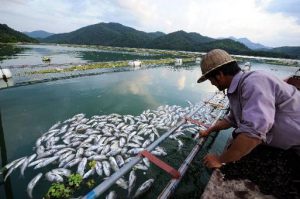Nature underpins global wealth creation. The renewable flow of goods and services provided by the earth’s ecosystems buttress our economy and yield benefits for business. But this stock of ecosystems – also known as “natural capital” – is largely invisible in financial decision-making. As a result, natural capital does not appear on the balance sheets of businesses and is largely unaccounted for in financial products.
Take for instance an investor in London, Shanghai or New York who finances a palm-oil development scheme in Indonesia or Africa, resulting in clearance of a large area of natural tropical rainforest. The dependency on and impacts of this investment on climate, food, energy, water and livelihood security are unlikely to be included in the cost of capital or debt, credit ratings on fixed income products, investment analysis or insurance premiums.
Most finance institutions still do not believe that natural capital is material to their bottom line. As a result, for many types of financial products there are at present no metrics available to incorporate it (quantitatively) in credit risk. But loss of forests affects water supplies vital to agriculture and hydropower. Greenhouse gas emissions from forest clearance account for about 12-15% of emissions globally. Species loss is immense, while deforestation can trigger community conflicts. Economists estimate forest loss alone is eroding natural capital and ecosystem services valued at US$1.2 to US$4.7 trillion per year.
There are also a number of ways natural capital consumption may affect the risk profile of an individual investor. First, there is a reputational risk, which may inhibit an institutions’ ability to raise funds in the future, based on a history of irresponsible investment.
Second, there are important legislative and liability considerations, demonstrated by a growing number of cases of companies being held financially responsible for biodiversity and ecosystem impacts. The EU Environmental Liability Directive (ELD), for example, makes companies directly accountable for impacts on water resources, fauna, flora and natural habitats. Operators of risky or potentially risky activities can therefore be held liable for the preventative and remedial costs of environmental damage. In these cases investors may be left exposed to any litigious action against the operating company which would adversely affect the price of their shares.
For industries dependent on natural capital, the continued erosion of global resources presents additional operational challenges. Exponential population growth is putting ever increasing pressure on the limited global natural capital base. The resulting surging demand in the past decade alone has reversed a 100-year decline in resource prices. Growing pressure on agricultural production, as well as associated water and energy requirements, from feeding an additional billion people by 2030 will trigger considerable increases in the price of global commodities.
These predicted price rises fall well within the investment horizon of pension funds and many project finance loans. And they represent potentially difficult supply-chain challenges for business and an important credit risk consideration for investors. A 2011 report by Ernst and Young found that 29% of profit warnings from FTSE companies were caused by increases in the cost of raw materials. For large financial institutions, where due to the complexity of their activities, the exact level of exposure to natural capital is often not fully understood, this represents a very real risk. A recent study by UNEP FI and PRI revealed that environmental externalities can equate to up to 50% of company earnings in standard equity portfolio.
Natural Capital Declaration
The Natural Capital Declaration, launched in June 2012, is an attempt to do something about this web of risks. The industry-led initiative aims to encourage widespread integration of natural capital considerations into financial products and services, and work towards their inclusion in financial accounting and reporting.
It isn’t the first step taken by the industry. Financial institutions began to address natural capital issues before 2012 through the adoption of the Equator Principles – a voluntary set of standards to help banks identify environmental and social risks linked to financing large projects like dams or mines – and the development of specific policies for environmentally sensitive sectors such as mining, oil and gas, forestry and chemicals. Leading companies are taking commitments to “green” their supply chains and some governments are making plans to account for natural capital nationally.
However, a systematic approach to understanding how a bank, an investment firm or insurance company impacts and depends on natural capital – indirectly through corporate customers, or directly through say, project finance – is lacking. Many institutions are in the dark about how to integrate natural capital considerations beyond project finance. The increasingly complex web of financial transactions held on a financial institution’s balance sheet, interbank lending, corporate finance and creative financial products, often mean that, as with the 2008 financial crisis, the location, dependency and exposure to natural capital and the risk of natural capital depletion is hard to measure.
The Natural Capital Declaration specifically aims to develop metrics and tools to help financial institutions integrate natural capital in a broad range of financial products including corporate finance, corporate and sovereign fixed income, private equity and insurance products.
As increasing global pressures chip away at stock of natural capital, businesses face mounting challenges. These can come in the form of legal liability, credit, reputational, regularity and portfolio risks, each presenting different threats and requiring additional mitigating measures. For example, climate-change driven shifting rainfall patterns have led to the destabilisation of the global commodities markets, exposing financial institutions to risks from increasingly unstable asset prices.
Market destabilisation is one consequence of a shrinking natural capital base, other examples might be: declining hydropower linked to increasing drought, political restrictions on the export of genetic material, an unexpected and irreversible collapse of fish stocks, stranded assets resulting from changing energy legislation, all of which present a material risk to financial institutions.
Acting now to boost profits
The outlook is not all bleak however. Understanding the risks posed by degradation of natural capital can bring a market advantage and the ability to generate additional returns at the same time as maintaining the global stock of natural reserves. Financial institutions can generate long-term profit from equity holdings in companies which, say, take serious measures to sustainably and responsibly source fish, or which take a long term view to managing timber reserves in paper and pulp supply lines. Such measures will not only benefit individual holdings, but also boost stability in markets dependent on natural resources.
Equally, as the corporate sector develops its natural capital agenda, integration of natural capital into business accounting standards will make it easier for financial institutions to discern profitable investments. Investments in new technologies which increase efficiency and cut consumption could also prove lucrative, as could low impact industrial processes.

Financial institutions can improve their market position by leading in this space, as well as through the development of certified products. The Roundtable on Certified Palm Oil, set up in 2004, had certified 11% of total palm oil production by 2011, for example. Similarly, the Marine Stewardship Council (MSC), which certifies sustainably managed fisheries, presently accounts for 147 fisheries and 2,000 seafood businesses, meaning around 8% of all wild caught seafood is certified by this standard.
Increasingly conscious consumers are driving the development of these markets. In the 12 months from 2010 to 2011, the volume of MSC certified products on retailers’ shelves increased by 62%. When seen this way, natural capital is very much a risk and reward game. Risk mitigation side by side with opportunity expansion makes for a smart proposition.




